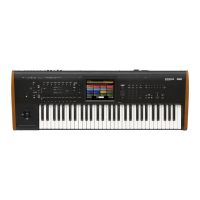EnglishFrançaisDeutschEspañol
Using the sequencer
En-23
Editing MIDI
You can modify your performance after recording, if you
wish. For instance, you can erase misplayed notes, or correct
their pitch and timing.
Timing correction is done through Quantization. This takes
the notes you played and lines them up to the nearest beat or
fraction of a beat, based on the resolution you select. It can
also be used to add a “swing” feel. Let’s try quantizing the
MIDI track we just recorded.
1. Go to the Sequencer P4: Track Edit page.
This page includes a graphic which shows each track in the
sequence. The small rectangles represent measures which
contain audio or MIDI data.
2. Select MIDI Track 01 from the popup above the
graphic.
Using the From Measure and To End of Measure
parameters at the bottom of the display, set the range of
measures that you wish to modify. For now, set From to 001,
and To End to 064.
3. In the page menu, select the Quantize command.
The Quantize dialog appears.
4. Set the Resolution to the desired rhythmic value.
As a general rule, choose the shortest note-value used in the
recorded performance.
5. Press the OK button to quantize the selected data.
If the result was different from what you had expected, press
the COMPARE switch to restore the song to the original
state before the quantization was applied. Experiment with
different Resolutions, set Intensity to less than 100% in
order to preserve some of the natural feel, or raise the Swing
value to create a shuffle or swing feel.
You can also apply quantization during recording, using the
REC Resolution parameter at the top of the P0 page. Choose
the desired resolution, and quantization will be applied as
you record.
For more information, see “Song editing” in the “Creating
songs (Sequencer mode)” chapter of the OG.
Template Songs
Template Songs store pretty much everything in the Song
except for the MIDI and audio data itself. This includes
Program selections, track parameters, effects and KARMA
settings, and the Song’s name and tempo.
The factory preset Template Songs let you get up and
running quickly with matched sets of sounds and effects for
various styles of music. You can also create your own
Template Songs with your favorite sounds and setups.
Note that Template Songs do not include MIDI data for song
tracks and patterns, audio data, and so on.
While loading a Template Song, you can also optionally load
one or more Drum patterns to a specified Track.
1. In the Sequencer P0: Play/REC page, press the page
menu button and select the Load Template Song
command.
A dialog box will appear.
2. In the From field, choose the Template Song you want
to load.
3. Check the “Copy Pattern to MIDI Track too?” check-
box.
When this box is checked, a dialog box for copying a pattern
will automatically appear after Load Template Song is
complete.
If this is not checked, only the selected Template Song will
be loaded.
4. Press the OK button to load the template song, or
press the Cancel button to exit without making
changes.
When you press OK, the Template Song’s settings will be
copied into the current Song.
If Copy Pattern to MIDI Track too? was checked in step 3,
the Copy Pattern To MIDI Track dialog box will appear.
5. Use the Bank (User or Preset) and Pattern popups to
select a pattern to copy.
6. In the To MIDI Track field, select the track to use for
the pattern.
Note: In each of the eighteen preset Template Songs, track 1
is always assigned to a Drum Program. (In some cases, other
tracks may also have Drum Programs.)
7. In the Measure field, set the measure on which you’d
like the pattern to start.
Following the names for each of the preset patterns, the
musical style and the name of the most suitable Drum
Programs are partially displayed.
By loading a Drum Program and the corresponding preset
pattern, you can instantly set up a drum track to match the
Template Song.
8. To load the pattern, press the OK button.
After the pattern is loaded, the Measure will count up
automatically. You can then copy another pattern if desired.
For instance, you can use different patterns one after the
other to build up a song, with different patterns for verse,
chorus, and bridge.
After you’ve finished adding patterns, press the Exit button,
and you’re done!

